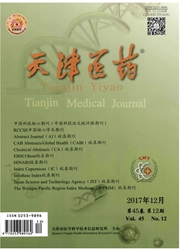

 中文摘要:
中文摘要:
目的:观察丹酚酸B(SalB)对糖尿病动脉粥样硬化ApoE基因敲除(ApoE-/-)小鼠模型斑块面积(PA)和斑块内晚期糖基化终末产物及其受体(AGEs/RAGE)表达的影响。方法:选取50只8周龄雌性ApoE-/-小鼠,腹腔注射链脲佐菌素200mg/kg联合高脂饲料喂养12周,将血糖水平〉11.1mmol/L的40只小鼠随机分为模型组(MOD)、SalB高剂量组(SalBH)、SalB中剂量组(SalBM)与洛伐他汀组(LVT)。SalBH灌服SalB160mg·kg-·1d-1,SalBM灌服SalB80mg·kg-·1d-1,LVT灌服洛伐他汀2.3mg·kg-·1d-1,MOD灌服等量蒸馏水,灌胃8周。实验期满后,取小鼠血样采用全自动生化分析仪测空腹血糖水平;取主动脉,制备石蜡或冰冻切片,分别行HE、免疫组化或苏丹Ⅲ染色,图像分析系统测量PA、血管横截面积(CVA)、AGEs和RAGE平均光密度值。结果:SalBM、SalBH及LVT组较MOD组PA/CVA明显降低(P〈0.01);SalBH组和LVT组的PA/CVA均低于SalBM组(P〈0.05)。与MOD组比较,SalBM、SalBH和LVT组的AGEs平均光密度值明显降低(P〈0.01);LVT组和SalBM组的AGEs平均光密度值均低于SalBH组(P〈0.05)。结论:SalB能够减少糖尿病动脉粥样硬化PA,该作用可能是通过降低斑块内AGEs的表达来实现的。
 英文摘要:
英文摘要:
Objective:To observe the effects of Salvianolic acid B (SalB) on plaque area and AGEs/RAGE expression of plaque in diabetic atherosclerosis animal models prepared from apolipoprotein E gene knock-out (ApoE-/-) mice treated by intraperitoneal injection of streptozo cin (STZ) and high fat diet. Methods:Fifty 8-week-old female ApoE gene knock-out mice were injected with STZ and fed with high fat diet for 12 weeks. Then the blood sugar level was measured and forty diabetic atherosclerosis mice were selected for the following treatment experiment. Diabetic atherosclerosis mice were randomly divided into four groups. Mice of each group was fed with same high fat diet and intragastrically administrated with different drugs for 8 weeks, named MOD group(distilled water), SalBH(SalB 160 mg·kg-1·d-1) group, SalBM group(SalB 80 mg·kg-1·d-1) and Lovastatin(LVT 2.3 mg·kg-1·d-1)group. The fasting blood sugar level(FBG) was measured by using full automatic biochemistry instrument. Frozen sections and paraffin sections of mice aortas were made and stained by Sudan Ⅲ staining or HE staining and immunohistochemistry staining. The plague area (PA), plaque area corrected by cross-sectional vessel wall area (PA/CVA) as well as the expressions of advanced glycation endoproducts (AGEs) and recepter of advanced glycation endproducts (RAGE) were measured and analyzed by Image-Pro Plus (IPP) version 6.0 system. Results:Compared with the MOD group, PA/CVA was reduced significantly in SalBH, SalBM and LVT treatment group (P 0.01). the values of PA/CVA were lovev in SalBH group and LVT group than that in SalBM groups (P 0.05). Compared with the MOD group, average optical density value of AGEs reduced significantly in SalBH, SalBM and LVT treatment groups (P 0.05). The average optical density values of AGEs were lower in LVT group and SalBM group than that in SalBH groups(P 0.05). Conclusion: SalB can reduce the diabetic atherosclerotic PA by decreasing the exp
 同期刊论文项目
同期刊论文项目
 同项目期刊论文
同项目期刊论文
 期刊信息
期刊信息
